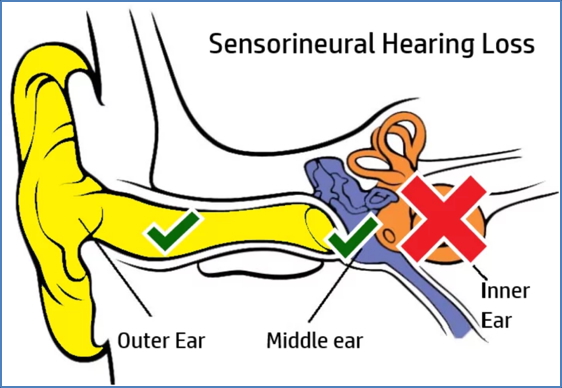Table of Contents
Overview – Deafness
Deafness, or hearing impairment, is a partial or complete inability to hear. It can result from problems in sound conduction, sensory structures of the inner ear, or neural pathways to the brain. For final-year medical students, understanding the key differences between conductive and sensorineural deafness, along with associated pathologies like tinnitus, is vital for clinical diagnosis and OSCE performance.
Conductive Deafness
- Definition: Failure of sound conduction through the outer or middle ear.
- Outer Ear Causes:
- Earwax (cerumen impaction)
- Foreign bodies (e.g. insects, beads)
- External otitis (infection, pus obstruction)
- Tympanic Membrane Causes:
- Perforation due to infection or trauma
- Scarring (tympanosclerosis)
- Middle Ear Causes:
- Otitis Media → Tympanic cavity fills with pus
- Otosclerosis → Fusion of ossicles impairs sound transmission

Sensorineural Deafness
- Definition: Damage to the inner ear, cochlear nerve, or auditory brain pathways.
- Common Causes:
- Noise-induced hearing loss → Damage to cochlear hair cells
- Acoustic neuroma → CN VIII tumour causing unilateral deafness
- Stroke in the auditory cortex
- Meningitis (inflammation of cochlea or nerve)
- Ototoxic medications (e.g. aminoglycosides, loop diuretics)
- Presbycusis → Age-related high-frequency hearing loss

Tinnitus
- Definition: Perception of sound without external stimulus.
- Common Descriptions: Ringing, buzzing, hissing, roaring, clicking.
- Cause: Often follows acoustic trauma (e.g. loud concerts)
- Pathophysiology: Damage to cochlear hair cells leads to aberrant electrical activity in the auditory pathway
- Note: Tinnitus is a peripheral auditory system issue—not a primary brain problem.

Investigations
- Otoscopy: Assess for wax, perforation, infection
- Tuning Fork Tests:
- Rinne’s test (AC > BC = normal or sensorineural; BC > AC = conductive loss)
- Weber’s test (lateralises to affected side in conductive loss, opposite side in sensorineural loss)
- Audiometry: Formal hearing test distinguishing type and severity
- MRI: If acoustic neuroma suspected
Management
- Conductive Loss:
- Wax removal, antibiotics for otitis, tympanoplasty for perforations
- Surgery for otosclerosis
- Sensorineural Loss:
- Hearing aids or cochlear implants
- Avoidance of ototoxic drugs
- Acoustic neuroma → Surgical or stereotactic removal
- Tinnitus:
- Avoid triggers (caffeine, loud noise)
- CBT, white noise machines
- Hearing aids (if hearing loss is present)
Summary – Deafness
Deafness can be classified as conductive or sensorineural, depending on whether the problem lies in sound transmission or neural processing. Accurate diagnosis using tuning fork tests and audiometry is key. Tinnitus, a related auditory symptom, often signals cochlear damage. For a broader context, see our Nervous System Overview.